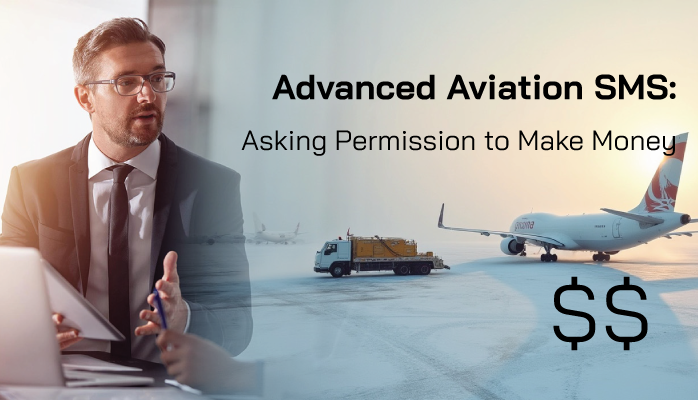Financial Opportunities Abound From Aviation SMS Processes

Aviation safety management systems (SMS) are designed to be implemented in a top-down managerial style for some "not-so-obvious reasons." For one reason, the "accountable executive" cannot accurately be considered "accountable" when safety initiatives and budgets exist beyond their direct control.
Accountable executives control organizational resources, including finances. Organizational safety financial decisions must be controlled and optimally championed by accountable executives.
Accountable executives understand:
- Current business strategy;
- Available and future budgetary constraints; and;
- Global, regional, and corporate business cycles.
Unfortunately, most accountable executives don't realize how much latent money-making potential resides within their aviation SMS implementations. This potential resides outside their purview.
In this advanced aviation SMS article, we assume you "influence" a functional SMS. Like many others, you may expect this core business function to earn the financial rewards so often promised in SMS regulatory guidance.
If processes are not easy, they are not sustainable!
Related Aviation SMS Implementation Articles
- How to Earn Top Management Support for Aviation SMS
- Distinguishing Between Responsibility, Authority, and Accountability in Your Aviation SMS
- Why Aviation Safety Managers Fail Without Dept Head Support in SMS
Untapped Potential Waiting to Be Recognized!
Consider that an aviation SMS has untapped financial potential due to the synergistic effect of their required components, including:
- Policy;
- System Design (Risk Management Framework);
- System Monitoring (Safety Assurance based on threat identification); and
- Safety Promotion (Training and safety culture development).
The majority of aviation SMS practitioners overlook synergistic financial potential because they remain perpetually focused on continuous safety improvement, and not on making money. Fortunately, I'm in a unique position allowing a more global perspective. My business background is now being called forward as hitherto my focus remained on discussing aviation risk management and promoting aviation SMS implementation.
Let's learn how to turn your aviation SMS into an income opportunity.
Why Ask Permission to Generate Profits From Aviation SMS Framework?

Since this article is about "asking permission" before making money from your aviation SMS framework, you can assume that permission will be required from the accountable executive, and in many cases, other senior managers before tweaking your aviation SMS implementation.
Small, yet impactful changes will be required. For example, your safety culture's "corporate message" may require modifications from "Safety First" to "Safety through Quality." Of course, this verbiage is only an example, as I have no insights into your current corporate safety motto.
Before we go any further, safety culture is important to achieve results.
Important Note: Safety culture is important to achieve results. I purposely omitted any adjective before "results." I did not say "safety culture is important for 'best results." While this is also true, if your safety culture is not trusting and toxic, your results will correspond to the efforts applied to improving employees' perception of a "just culture." Employees participate most eagerly for a variety of reasons, chiefly economic, but when they sense an opportunity to "make a difference," you are working with a different caliber of employees.
I don't preach "just culture" for moral reasons. I preach "just culture" for business reasons. The economics speak for themselves. Consider aggregated training and recruitment costs for a company with a 2-year employment turnover average versus a company with a ten-to-twelve-year employment turnover.
SMS is Business!
Your safety culture may face challenges today, but if you already possess a regulatory-compliant aviation SMS, there is hope! You already have the necessary tools to effect positive, incremental change.
Again, for reinforcement... before you begin, you need to seek permission. This should be fairly easy, as most managers want to make money, but not all! The biggest challenge is educating managers as to "what are possible credible outcomes" from maximizing the utility of an existing "core business function," which SMS has become within the past decade.
Acquire Allies From Senior Management
The most successful aviation safety cultures always enjoy top management support.
Question: How can an organization increase the chances of receiving top management support?
Answer: By demonstrating to senior management the aviation SMS initiative can generate profits within a reasonable time period.
The quickest way to acquire steadfast top management support is not through grand visions of a just, safer world. Management prefers a vision of more money! Aviation SMS implementations possess all the tools to bring in revenue as well as manage SMS documentation requirements. If your company has already spent the time and money acquiring and implementing these tools, why isn't your organization making money from the investment?
Where does this money come from? Reduced injuries? Savings from employee negligence? Where? Where?
It is natural that you may be wondering where these revenues will come from. While each company is different in size and scope of operations, these financial benefits are captured from identified opportunities and the reduction of those annual, recurring expenses related to damage and neglect.
How is this accomplished using an aviation risk management system? I will demonstrate how, but it will take more than one blog article.
Related Articles on Aviation SMS Implementation Benefits
- 43 Benefits of Aviation Safety Management Systems (Proven)
- Why Should We Implement Aviation SMS?
- What Are Main Components of Every Aviation SMS Implementation?
Aviation SMS Implementations Under-Utilized in Most Cases
Your aviation SMS delivers the potential of a multi-million-dollar risk management system if implemented properly. Your SMS should be considered a money-making machine and not simply a sunk cost delivering no value. The reality is that your SMS will return what you put into it.
Have a substandard safety culture? Change it! You have power!
This is an advanced SMS topic. You are reading this article for various reasons, maybe for sheer entertainment. Hopefully, you want to learn how to reap promised SMS rewards that up until now, have been eluding you.
When I first started my aviation SMS career in 2007, Peter Gardiner (former President of Southern California Safety Institute - SCSI) taught me about the "aviation business reality."
Peter taught us the most effective tactic to convince senior managers to fully embrace aviation SMS concepts and philosophy. For senior managers to accept SMS as an equal organizational "business unit," they needed to learn how their aviation SMS could save them money by;
- Identifying latent and recurring operational threats;
- Documenting financial costs from operational damage to determine root cause and prevent recurrence; and
- Utilizing proven risk management workflows for managing other types of operational concerns besides safety.
I wholeheartedly agree with Peter Gardiner. Yet I also believe that aviation SMS has even more power to facilitate the identification, capture, and execution of opportunities that would have otherwise gone unnoticed, or if they were noticed, the organization may not have the time or resources to execute the opportunity.
Aviation SMS Provides Opportunities in Unlikely Places

Your aviation SMS contains a rich framework for:
- refining the organization's mission;
- shaping your safety culture;
- managing risk in repeatable, industry-approved workflows, as well as
- identifying and executing opportunities.
The challenge that Peter Gardiner and many other aviation safety thinkers have realized is that more educational awareness must be given to our senior managers. We used to see more of these "SMS for Executives" training courses offered.
All too often, I see managers moving up through the ranks who don't understand the business side of safety. These uninformed managers see safety as a business department not directly contributing to revenue generation. Consequently, the safety department loses valuable attention as a tool to mold the organization into an efficient aviation enterprise always seeking opportunities from adversity. This requisite mindset propels a successful business culture.
Aviation SMS is business. If you are reading this article, we should remain aware of this mindset.
Related Aviation SMS Articles
- How Top Management Kills Your Aviation Safety Culture - With Examples
- How Money Shapes Safety Culture in Aviation SMS
- Why Money Is More Important Than Safety in Aviation Safety Cultures
Let's Cut the Aviation SMS Budget Again!
In most cases, senior-level managers don't see SMS as an income-generating opportunity, but as a necessary expenditure to minimize every possible opportunity.
As an extreme, yet common example, I've seen multiple companies cut safety budgets as their companies doubled or tripled in size. In hindsight, or perhaps from an outsider's perspective, we can readily see that cost-cutting strategies are not congruent with business expansion.
Another short-sighted business strategy I've witnessed repeatedly over the past year is cutting safety expenditures during uncertain times. When marginally-employed employees are stressed about whether they will have a job next week, we need to be delivering more safety services and not cutting them. In cases I've seen, I'm certain the draconian cost-cutting message is coming from the top to cut expenditures indiscriminately. Safety managers must understand how to communicate this risk to senior managers.
How to Make Money From Your Aviation SMS Implementation?
Operators with more than ten employees will find more opportunities to make money from SMS implementations. Smaller companies simply don't have the scale or resources to benefit as greatly as companies with more employees.
I believe that companies with 50-750 employees will benefit the most from tweaking their SMS implementations to generate profits. Companies with more than 500 employees commonly have quality management systems that should obviate the need for the tactics I'm sharing.
Earning revenues from the aviation SMS becomes logically possible as operators expand the scope of their "existing management systems" to include both:
- Safety; and
- Quality.
There are some requirements to begin and these strategies are not for every company. First, you will need to get management's permission to:
- ensure SMS activities align with the core business strategy;
- slightly adjust your organization's safety focus and culture; and
- evaluate whether your existing aviation SMS framework supports "automated opportunity management."
Related Articles on Integrated SMS and QMS
- QMS Programs vs Aviation Safety Management Systems (SMS)
- 4 Considerations about QMS and SMS in Aviation Safety Management
- Moving From Quality Management to Integrated SMS and QMS Systems
Final Thoughts on Optimizing Aviation SMS Activities
For over a dozen years, many of us have read SMS guidance materials preaching the benefits of aviation SMS.
Most operators are underwhelmed with the performance of their implemented SMS!
Why?
Where are the savings? How is our SMS paying for itself?
In most cases, the aviation SMS is a recurring sunk cost that embitters managers. I can show you how to make money with your SMS. Are you ready?
I plan to show you how to configure your SMS Pro database to capture profits. This will excite senior management because it aligns with their mission.
In this "Advanced Aviation SMS" series, I will discuss six to eight topics necessary to turn your glorified safety risk management system into an "opportunity-seeking, integrated safety and quality management system."
Stay tuned for future Advanced Aviation SMS topics.
This topic is aimed at a large group of SMS Pro managers. You do not need SMS Pro to effect these changes. However, you will need an automated database for sustainability. More details coming.
Need a change of pace in SMS documentation management?
If your aviation SMS data management strategy is not delivering, you have choices to continue to endure the pain or make the switch. Before you make the switch, you should ask some questions:
- Have employees have been properly trained on the SMS database?
- Does my system have everything I need?
- Is there a potential to make money from our system?
If you cannot expect your aviation SMS to pay for itself in the future, I submit that you are not executing SMS principles properly. This could be from a lack of tools or a lack of training. Each case is a bit different.
If you are searching for advanced SMS analytical and risk management tools, I recommend SMS Pro for healthier companies. I have another recommendation for cash-strapped developing countries.
These short demo videos offer a glimpse into one of the most popular aviation SMS databases.
Last updated in October 2025.







